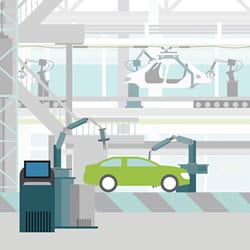Connected vehicles shift an industry has been saved

Analysis
Connected vehicles shift an industry
On the road to predictive maintenance and safety
All lanes merge toward connectivity. So how can original equipment manufacturers (OEMs) —and the auto industry at large—better manage Internet of Things (IoT) cars and realize greater value from the vast amounts of data they produce? And how can vehicle connectivity translate to improvements in predictive maintenance and safety?
Explore content
- As costs drop, data revs up
- Turbocharging the industry
- Watch the video
- Avoid bumps in the road
- Gearing up: How Deloitte can help
As costs drop, data revs up
There’s no U-turn on the connected cars highway. With consumers demanding continuous connectivity, governments requiring the installation of sensors for better safety, and automakers embracing data to improve customer service and satisfaction, there’s simply no turning back.
And there’s no slowing down.
It’s estimated that there will be 470 million connected vehicles on highways around the world by 2025. Those connected vehicles will each produce roughly 25 gigabytes of data per hour.1 But could that projection actually be conservative? As mobile network providers continue to innovate, data becomes less expensive, and well-meaning engineers can install even more sensors in vehicles.

Turbocharging the industry
Typically, terms like “connected cars” or ”connected vehicles” bring to mind the benefits the automotive industry provides to customers, such as the ability to analyze connected data to help consumers customize vehicle preferences and enhance their driving experience. But connected vehicles—and the data they produce—offer an array of potential benefits for nearly all business partners in the automotive industry.
Vehicle connectivity can potentially help OEMs reduce warranty expenses, shorten reaction time to product flaws, and optimize signal-to-noise ratio from trouble codes. Access to better data can also provide better insight into the reliability of suppliers, helping OEMs to select the best partners for their needs. Suppliers, in turn, can potentially optimize lead time and gain value from better planned supply chains.
For fleet owners, connectivity enables fleet health to be tracked at vehicle identification number (VIN) level to better predict potential imminent failures. It can also decrease breakdown time and improve control over vehicle maintenance.
And for dealerships, increased connectivity could lead to automated repair scheduling, more accurate predictions of repairs needed before a vehicle is brought in for service, and better visibility into parts availability and quality issues—all of which can lead to greater customer satisfaction.

Connected vehicles and innovative analytics: Did you know?
Watch the video to learn more.
Avoid bumps in the road
But all that data has a downside as well, because all that data can be difficult to manage. And if not managed correctly, it could easily lead to bumps in the road. So how can you better harness data from IoT cars to improve predictive maintenance and preventive safety? How can you monetize this data to realize greater business value? Put yourself in the driver seat and consider these questions:

OEMs
- ● Are you struggling with low signal to noise ratio in connected data when identifying the right signals to address?
- ● Do you have a platform that can dynamically recommend actions for prioritized trouble codes?
- ● Do your systems support automated service scheduling for prioritized VINs?
- ● Are you leveraging intelligent supplier reliability insights to support sourcing and negotiations?

Suppliers
- ● How does connectivity to OEMs help you get a jump on which parts are needed?
- ● How can connected data be leveraged to improve the diagnosis and root cause analysis process?

Fleet owners
- ● How are you tracking fleet health at VIN level to reduce operational costs?
- ● What real-time data are you leveraging to help reduce downtime and increase ROI?
- ● How are you optimizing fleet maintenance schedules using connected data?

Dealerships
- ● Are you leveraging connected data to improve customer experience?
- ● Could connected data help resolve inventory management and other operational challenges?
Take command of the road—and vehicle connectivity
There are many opportunities for OEMs, fleet owners, dealerships, and suppliers to realize greater value on the investments they’ve made in sensors and connected vehicles. When it comes to connectivity, let Deloitte Risk & Financial Advisory help you take command of the road ahead.
References
1 “470 Million Connected Vehicles On the Road by 2025,” ITSdigest, February 16, 2018.

